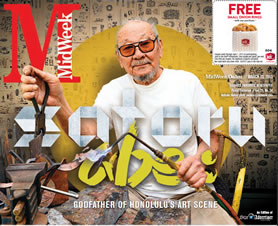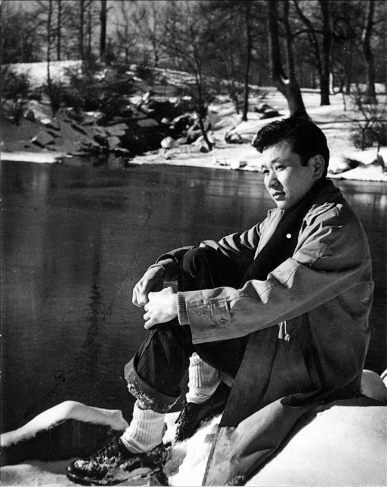Satoru Abe: Godfather of Honolulu’s Art Scene
Who is the elderly Japanese man who has been walking the neighborhood? He is small in stature, quiet, and his clothes are stained, torn and marked with burns.
His eyes light up and a smile broadens, filling his face, as he describes living with relative anonymity in Kaimuki. If you haven’t yet become acquainted with our living legend, one of Hawaii’s most renowned creators of fine art, allow me the honor of introducing you to the touchingly humble and incredibly talented Satoru Abe, whose clothes bear the marks of his diligent night and day absorption in his craft.
He quickly shies away from talking about himself.
“I already know all about myself,” he quips.
But talk about the love of his life, his sculptures and paintings, and the words overflow.
Born in 1926 in Moiliili, Abe grew up near Kaheka Lane. Now it’s Kaheka Street, but he remembers back when it was a lane and all the roads in the area were dirt. Young Abe attended McKinley High, where he developed an aptitude for art.
“I was working for Dairyman’s (after high school). I was an assistant pasteurizer,” says Abe. “I realized, is this what I’m going to be for the rest of my life? That’s when I decided I’m going to be an artist. I went home and told my parents and they gave me their blessing. They said ‘Well, be prepared to be poor.'”
In 1948, Hawaii was not known for its fine art. To become a serious artist meant going to New York. Yet, for the eldest son in a traditional Japanese household to leave his family and travel abroad was highly unconventional. But younger brother Fred readily stepped up to the task of family caretaker so Abe could follow his paintbrush. Armed with only an undeniable but neophyte passion for Rembrandt, he set out for New York.
“Imagine 1948, from here to California, it was by ship,” says Abe. “Everyone at the pier sending you off with flowers and lei as though they might never see you again. I went to California first, did some menial jobs to get by, and then went to Chicago, and finally New York.”
He arrived at Grand Central Station, too late in the evening to call the number he had in his pocket. So he spent his first night in Central Park. He delved into his studies, attending the Art Students League during the day and getting by with a job as a dishwasher in the afternoon. During a smoke break in a classroom hallway one day, he met an attractive girl, Ruth, who happened to be from Wahiawa. He was studying painting; she, fashion design. By 1950, the two were married and returned to Hawaii, where they welcomed baby Gail into the world.
Most significantly, at this time, Abe celebrated the birth of several creative partnerships. He formed productive friendships with fellow up-and-coming artists Bumpei Akaji, Tadashi Sato, Edmund Chung, Tetsuo Ochikubo, Jerry Okimoto and James Park, most of whom also had just returned from studying in Italy, Chicago and other art enclaves. The seven Asian-American artists inspired each other in a little art niche they’d set up on Metcalf Street, and together they grew to acclaim as the Metcalf Chateau. It was around this time that Abe met his mentor Isami Doi.
Each member of the Metcalf Chateau already was accomplished at the individual level. As a group, they were a powerhouse in Hawaii’s burgeoning art scene. As the public caught on, they clamored to claim their part in history-in-the-making. Abe lights up as he recalls the group’s first big show together in 1954: “At the reception, I don’t think we had 50 people. Today, everybody says, ‘I was there,'” he laughs.
Abe eventually looked for inspiration in Japan and held solo art shows there before moving his family back to New York in 1956 to study sculpture.
“I looked in the phone book for a sculpture center,” says Abe. “I caught the bus from the West Side to the East Side and dropped in. ‘I am from Hawaii, I’m looking for a place to weld.’ ‘Why don’t you go up to third floor?’ the lady said. I went up to the third floor and couldn’t believe it.”
He had happened upon a floor dedicated to professional welding – and his big break into the world of sculpture. The second floor offered lessons and the first floor was a gallery. When Abe returned to Hawaii in 1970, he was well-established, his sculptures having been displayed at various venues, including the Museum of Modern Art in New York.
Abe’s prodigious career has produced more than 5,000 pieces of art. He is the last standing of the Metcalf Chateau group, and he continues to sit at his outdoor studio setting his torch to metal during the day and painting in the evenings. Abe is so consumed by art, he even dreams about it.
“I hope to die working,” he says. “I’m good for 200 more pieces of artwork, and I hope half of them will be a surprise. Creativity is about surprising yourself.”







